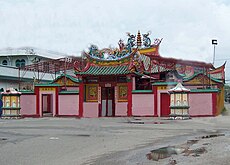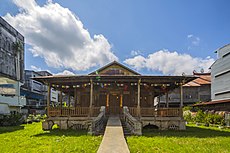Bagansiapiapi
Bagansiapiapi or simply known as Bagan (Chinese: 峇眼; Pe̍h-ōe-jī: Bā-gán) is a city in Riau province on the island of Sumatra, Indonesia.
The town was originally populated mainly by Chinese immigrants[3]: pp xii who arrived at the end of 18th and the beginning of 19th century.
[citation needed] Most of the Chinese population are Hokkien, originating from Tang-Ua (TongAn, now part of E-Meng/Xiamen), Kim-Meng (Kinmen, Quemoy, JinMen), and Cin-Kang (JinJiang/Jinjiang).
Most of the youth leave the town after high school to pursue a better life, or higher education in larger cities.
[6][7] Due to the town's progress compared to other areas of afdeeling in Bengkalis, Bagansiapiapi was called as Ville Lumiere or (City of Light).
The town's heyday came under the jurisdiction of the Dutch East Indies, around 1930, when the fisheries produced 300,000 tons of fish per year.
[9] Bagansiapiapi's made boats are capable of penetrating various types of marine characteristics so that they are also used in Java, Nusa Tenggara, and Maluku.
The law states that the central government has full authority to determine the division of forest areas.
Majority ethnic group of the city are the Chinese with large minority Malay population, while the Minangkabau and Batak are the remainder.
Each year, the ritual brings in tourists from Malaysia, Singapore, Thailand, Taiwan, and Mainland China to Bagansiapiapi.




